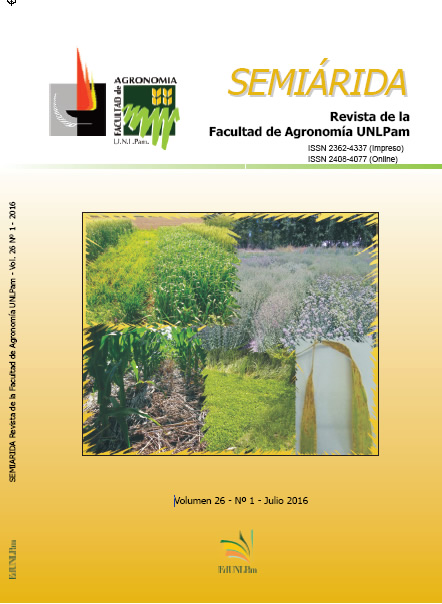Producción de diferentes cultivos invernales en la región semiárida pampeana
DOI:
https://doi.org/10.19137/semiarida.2016(01).19-24Palabras clave:
adaptación, cultivos alternativos, trigo panResumen
El trigo pan es el cultivo invernal más importante en la región semiárida pampeana, aún
con el escenario de alta volatilidad de precios. Existen alternativas como la cebada forrajera
y cervecera, avena, centeno, trigo candeal, alpiste, triticale, colza, cártamo y lino. El objetivo
fue evaluar la factibilidad de producción de éstos. Los ensayos se realizaron en el campo de
la Facultad de Agronomía de la UNLPam (36º32’54” S; 64º18’16” W), sobre un suelo Paleustol
petrocálcico. Se utilizó un diseño de bloques completos al azar con 3 réplicas. Se sembraron
tres épocas (2/06, 21/06 y 14/08). Las lluvias fueron suficientes para todos los cultivos, excepto para el cártamo en diciembre y enero. Los mayores rindes se lograron con el trigo pan,
la cebada cervecera y forrajera de la tercera época y el triticale en la segunda. La avena, la
cebada forrajera y cervecera, el centeno, el trigo candeal, el trigo pan y el cártamo tuvieron
mayor rendimiento en la tercera época. El alpiste, el triticale y el lino rindieron más en la segunda época. El alpiste, el cártamo y el lino tuvieron menores rindes; su evaluación por parte del agricultor dependería de la visión de cadena de valor, nicho de mercado y rentabilidad
empresarial.
DOI: http://dx.doi.org/10.19137/semiarida.2016(01).19-24
Descargas
Citas
Allen R., L. Pereira, M. Smith & D. Raes. 1998. Crop evapotranspiration - Guidelines for computing crop water requirements - FAO Irrigation and drainage. FAO - Food and Agriculture Organization of the United. 56: 17-28.
Balzarini M., J. Di Rienzo, M. Tablada, L. González, C. Bruno, W. Robledo & F. Casanoves. 2012. InfoStat profesional versión 2.0.Manual del Usuario, Editorial Brujas, Córdoba, Argentina. 400 p.
Calzada J. & D.S. Corina. 2015. Para sembrar trigo en la campaña 2015/16 habría que invertir 1.500 millones de dólares. En: Informativo semanal. Bolsa Cereales Rosario. pp 5-7. Rosario, Argentina.
Cattáneo M. 2011. Los mercados de cebada cervecera en la Argentina y en el mundo. En: Cebada Cervecera (Eds. Miralles D.J, Benech-Arnold R.L. & L.G. Abeledo). Facultad de Agronomía UBA. pp. 275-284.
Caviglia O.P & F.H. Andrade. 2010. Sustainable Intensification of Agriculture in the Argentinean Pampas: capture and use efficiency of environmental resources. Americas J. Plant Sci. Biotech. 3(1): 1-8.
Caviglia J.A., H.O. Lorda & J.D. Lemes. 2010. Caracterización de las unidades de producción agropecuarias en la provincia de La Pampa. Bol.de Div. Técn. Nº 99. INTA - EEA Anguil, La Pampa, Argentina.
Fernández M.A. 2008. La estabilidad del rendimiento de trigo candeal (Triticum durum Desf.) en la región de las planicies con tosca de la provincia de La Pampa. Rev. Fac. Agron. UNLPam. 19: 41-62.
Ferreira V., E. Grassi, A. Ferreira, H. di Santo, E. Castillo & H. Paccapelo. 2015. Triticales y tricepiros: adaptabilidad e interacción genotipo-ambiente del rendimento en grano. Chilean J. Agric. Anim. Sci. 31: 93-104.
Girola. C. 1915. El cultivo de lino para la producción de semilla en la Argentina (Eds. Cabaut & Cía.). 196 p.
Quiroga A., M. Díaz-Zorita & D.E. Buschiazzo. 2001. Safflower productivity as related to soil water storage and management practices in Semiarid regions. Commun. Soil Sci. Plant 32(17-18): 2851-2862.
SIIA. 2015. Sistema Integrado de Información Agropecuaria. Estimaciones agrícolas. http://www.siia.gov.ar/_apps/siia/estimaciones/.Visitada en Mayo de 2015.
Soil Survey Staff. 1999. Soil taxonomy: a basic system of soil classification for making and interpreting soil surveys Agric. Handbook (2nd ed.), USDA vol. 436, 869 p.
Vergara G.T. & G. A. Casagrande. 2012. Estadísticas agroclimáticas de la Facultad de Agronomía, Santa Rosa, La Pampa, Argentina, 1977-2010. Rev. Fac. Agron. UNLPam. 22: 1-75.
Walkley A & I.A. Black. 1934. An examination of the Dejtjareff method for determining soil matter and a proposed modification of the cromic acid triation method. Soil Sci. 37: 29-38.
Descargas
Publicado
Número
Sección
Licencia
La Editorial de la Universidad Nacional de La Pampa (EdUNLPam) exigirá a los/as autores/as la firma del siguiente documento:
La EdUNLPam lleva a cabo la publicación del artículo: (Título del Artículo) en SEMIÁRIDA Rev.Fac.Agron UNLPam ISSN 2362-4337 (impresa) ISSN 2408-4077 (en línea), del cual el/los abajo firmantes son autores de una o más partes. En el mismo acto, el/los autores entregan exclusivamente a la EdUNLPam todos sus derechos protegidos por las leyes de propiedad intelectual que rigen en la Argentina para reproducir, publicar, editar, fijar, comunicar y transmitir públicamente en cualquier formato o medio impreso o electrónico, inclusive internet, el artículo enviado a publicación e incluirlo en índices o bases de datos nacionales e internacionales. A cambio, la EdUNLPam entrega a los autores la autorización para la publicación o reimpresión con ines académicos y educativos en cualquier libro o medio de divulgación, con la sola obligación de citar el artículo original publicado en la EdUNLPam. Cada autor acuerda en que el material provisto a la EdUNLPam es un trabajo original, que no ha sido impreso o publicado en cualquier otro medio con anterioridad y que no vulnera derechos de terceros. El Primer autor tendrá la posibilidad de leer y corregir el artículo ya editado como “prueba de galera”, pero si el autor no devolviera esas correcciones de la prueba de galera dentro del tiempo especificado, el proceso de producción y publicación podrá proseguir sin la aprobación del autor. El/los autor/es no recibirán compensación monetaria de la EdUNLPam por el uso del material contenido en este artículo y asumen la responsabilidad de las opiniones vertidas en él.










.png)



22.png)


.jpg)




.jpg)
10.png)



